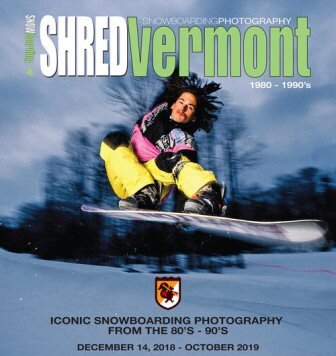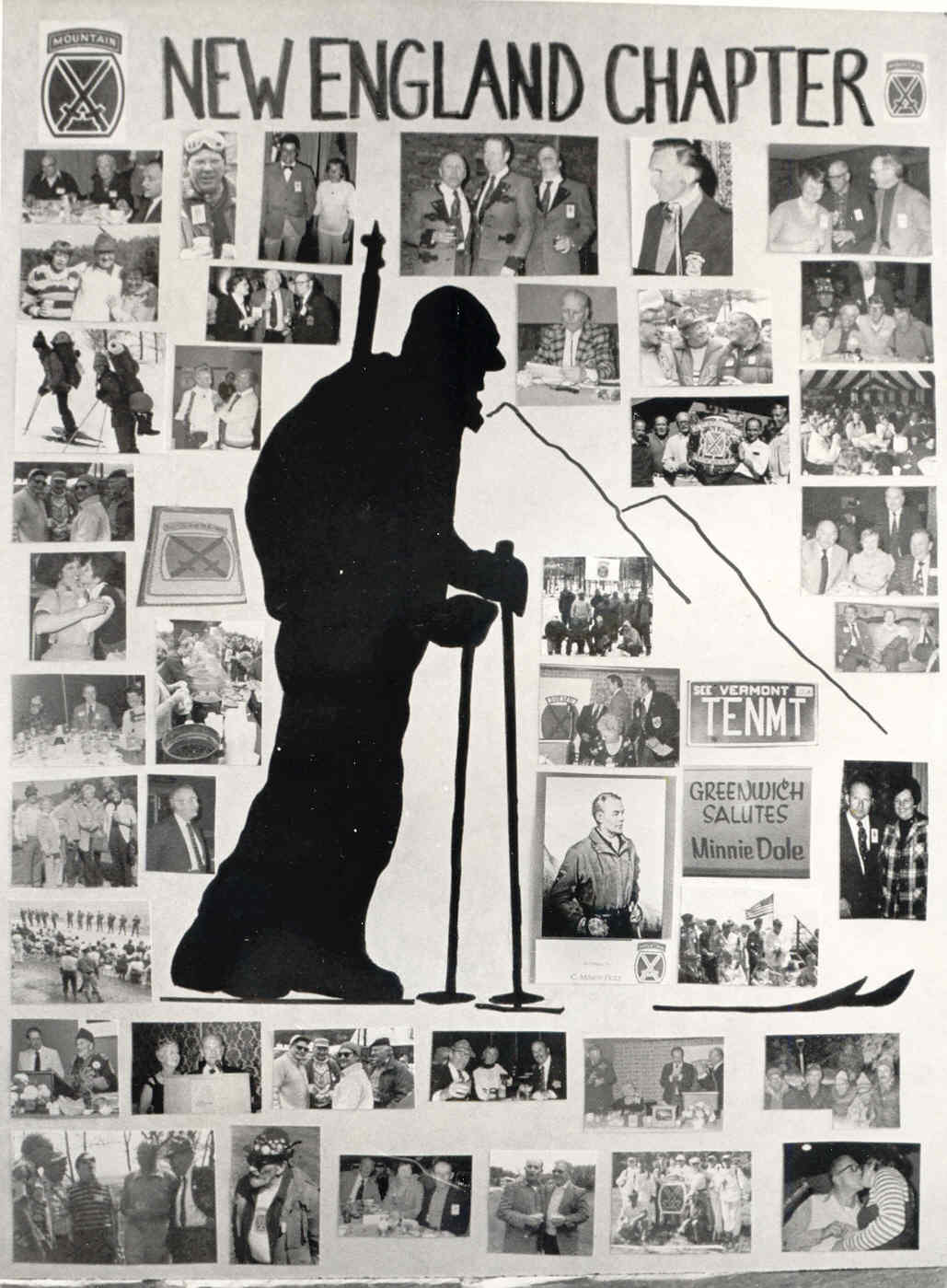Current Exhibit
Searching for Vermont’s Lost Ski Areas, Part I
December 1, 2023 - October 14, 2024
Have you ever heard of Hedgehog Hovel, Buckturd Basin, or Freak Peak? All are part of Searching for Vermont’s Lost Ski Areas.
This is a schuss down memory lane for those who learned to ski or ride at any one of Vermont’s 175 “lost” areas.
The Museum’s search for information about Vermont’s “lost” ski areas, those that at one time operated a mechanical tow, has been a more than 20-year endeavor. 175 “lost” areas from Vernon to Newport have been identified and located on a large format map created for the exhibit. “Lost and found” ski areas, and twenty areas still in operation today, are also identified.
Drawing from information, photographs and memorabilia in the museum’s collection, and with help from local historical societies and NELSAP, Part I of Searching for Vermont’s Lost Ski Areas features the unique character of 70 “lost” areas between the Massachusetts border and Rte. 4, from small community tows to bigger areas with multiple lifts.
Of those 70, Woodstock, Snow Valley, Dutch Hill, Hogback, and Mt. Ascutney are highlighted with even more detail and colorful information. Visitors will learn about the installation of the first rope tow in the United States, snow trains and the beginnings of ski tourism, the first snowmaking system in the state, and Vermont’s first Sno-Cat skiing operation.
The search for more information about Vermont’s lost ski areas is ongoing and the Museum welcomes input from those who have memories and photos to share. Part II of the exhibit will push further north and will open next season.
Do you have information, stories, or memories from a “lost” ski area? Please share by clicking the link below.
Want to support our exhibits? Make a donation today!
Past Exhibits
Scott Lenhardt: Artistic Contributions to Burton Snowboards, 1994 - Present
November 2022 to October, 2023
West Rupert, Vermont native Scott Lenhardt has done over 55 graphics for Burton Snowboards, and he’s not done yet. He did his first graphic for them in 1995 while still in college and over 25 years later he’s still pumping them out including signature graphics for Ross Powers and Danny Davis. Scott was part of our Art of the Graphic exhibit and when collecting his pieces for that show he made the comment ‘I have everything’ which was the spark for this solo show of Scott’s amazing work.
In addition to snowboard graphics, Scott has done work for Phish, Nike, Adidas, Mountain Dew, and Vice Magazine. He’s done numerous pet portraits and a very humorous series called Twenty Four Hour Woman, but he’s best known for his work with Burton.
Scott grew up snowboarding in Southern Vermont and was part of the notorious Glebelands crew, who could be found shredding Bromley in the early/mid ‘90’s.
This exhibit features select works from throughout his career that allow the viewer to step into Scott’s work as it progresses from concept to the full-sized paintings and the boards they become. The detail that Scott works into his art is incredible and much of it is hidden to the uninformed but will come to life with Scott’s insights on the work that are part of the exhibit. Intermixed will be other works from Scott that exemplify the range of his imagination.
There will be an extensive selection of work for both Ross Powers and Danny Davis, including the art behind Danny’s current Deep Thinker series.
The exhibit was open through October 2023.
Check out the photos from the Opening Party here.
Seven Days Article: A Burton Snowboards Exhibit Spotlights Artist Scott Lenhardt’s Rad Skills
The Art of the Graphic; How Ski and Snowboard Graphics Come to Life
Here’s a quick look at the Art of the Graphic.
Manufacturing technology and new materials have led the evolution of ski and snowboard performance, but how boards look is just as important to many skiers and riders. Top sheet graphics play a huge role in the purchase decision for many. ‘The Art of the Graphic’ takes a look at the art and the artists behind some of our favorite skis and boards.
In this exhibit, all aspects of the creative process, including design briefs, concept sketches, notes, paintings, collage, digital art, and more, including the finished commercial product will be on view.
The eight displays are a cross section of concepts from original paintings to computer generated art. For snowboards, graphics from Burton feature collaborations with well-known artists Scott Lenhardt and Mark ‘Gonz’ Gonzales, both doing graphics for Danny Davis’s Deep Thinker series and painter/musician Mikey Welsh working with graphic artist Dennis Healy on the Farm series. Pallas Snowboards, a women’s only brand, shows a graphic collaboration between painter Mishel Schwartz and graphic designer Lenka Prochazka. Finally, Rome Snowboards art director Michael Paddock show how graphics can come from unlikely places, in this case the doodle board in the marketing office at Rome.
Ski brand Nordica shows the evolution of its top selling Enforcer graphic done by Josh Brown and Jeff Rooney of Capacitor Design Network. J Skis and designer Tim Clayton display a collaboration with Japanese artist Tetsuya Abe and his ‘one-stroke’ painting method. Clayton also worked with Atomic Skis in a complex Grateful Dead collaboration for a Chris Benchetler signature ski. Coalition Snow, a women’s only ski company, shows how at small companies the owner is also sometimes the designer with art done by founder and owner Lauren Bello.
Two Contests: Competing in Biathlon
Green Mountains, White Gold will touch on Vermont’s role in the early development of Nordic skiing, while this exhibit examines biathlon, the only Olympic sport in which competitors perform two distinctly different skills - cross country skiing and marksmanship - concurrently. To understand biathlon, John Morton, VTSSM Hall of Fame Inductee and former biathlete, suggests: “...take a person that doesn’t necessarily have skill in skiing, ask them to run up 10 flights of stairs as fast as they can and ask them to thread a needle when they get there; you get an idea of how challenging it is to be precise when you have stressed yourself to that level.” Vermont has lead the way in developing biathlon training facilities and youth development programs through a unique partnership with the US Army and Vermont National Guard. The exhibit will examine the relationship between biathlon and the military – making connections to the 10th Mountain Division, the pioneering efforts of Vermont ski clubs and ski areas in providing training and facilities, and the success past and present Vermont athletes have had internationally, and their role in increasing the awareness of biathlon in the US. Click the button below to hear biathletes talk about biathlon - the sport, history, training, and competition.
ORIGINS: Three Exhibits on Skiing and Riding in Vermont
Through three exhibits, the Museum will use photographs, objects, and film to look at how Vermonters used technology, geography, and invention to move skiing and riding forward. Innovation happening in tiny Vermont has had a large and lasting impact on the development of recreational and competitive snowboarding, downhill and Nordic skiing.
Green Mountains, White Gold: Origins of Vermont Skiing
The Vermont Ski and Snowboard Museum is proud to partner with the New England Ski Museum in bringing this exhibit to Vermont. The New England Ski Museum’s photographic timeline documents the earliest days of recreational skiing in Brattleboro and Woodstock Vermont. The photographs continue with topics such as the CCC at Stowe, early snowmaking at Ascutney, and creation of resort communities at Mt. Snow. Museum visitors will learn more about the who, what, when, and where of skiing in Vermont from the early 1900s to the 1960s. Using items from the Vermont Ski and Snowboard Museum’s collection to supplement the photographs and text, the new exhibit will show how skiing and snowboarding evolved over time thanks to the ingenuity of Vermonters, the unique landscape, and the reactions to world events and cultural changes. Click the button below to see a narrated sampling of photos from the exhibit.
Surfing Snow: Vermont Inspired Boards
In recognition of JG Gerndt’s 2019 induction into the Vermont Ski & Snowboard Hall of Fame, the Museum invited him to curate a collection of boards that tells the story of snowboarding technology. First as a team rider, then as a full-time Burton employee in product development, JG, over a thirty-plus year career in Vermont, has played a preeminent role in designing revolutionary surf-inspired boards for legendary riders like Terje Haakonsen, Danny Davis, Dave Downing, along with fellow Museum Hall-of-Famers Jeff Brushie and Ross Powers (to name a few). JG’s experience, impact, and influence have earned him an affectionate nickname among his peers: “Yoda.” His passion and hard work have planted seeds of innovation that have changed the way people enjoy snowboards around the globe. The exhibit will feature JG’s commentary, written and video, on the original Fish from 2002, Malolo, Mod Fish, Split Fish, Fishcuit, Pile Driver, Root, Resonator, Backset Drive with a Fish 3D, to show where the sport is going. A special thanks to Burton’s archives for loaning an example of each board. Click the button below to hear JG describe the technology and design of each board.
PEAK To PEAK: 10th Mountain Division Then and Now
The exhibit highlights the evolution of the 10th Mountain Division's equipment and training since its beginnings in 1943 to today. The idea for US mountain troops was borrowed from Finland and Russia and brought to the Army at the start of World War II by C. Minot "Minnie" Dole. Dole also founded the National Ski Patrol, and drew heavily on its membership to populate the mountain division. The 10th did most of its training at Camp Hale, Colorado before deploying to Italy to help close the Italian front and end the War.
The Museum worked closely with the 10th Mountain Division and Fort Drum Museum to prepare this exhibit. Additionally, the Museum relied on the Vermont National Guard and Army Mountain Warfare School, based in Jericho, Vermont, for information on how they train elite Army soldiers from all over the country in military mountaineering.
SHRED Vermont - Iconic Snowboard Photography 1980-2000
Vermont played a critical role in the development of snowboarding in the early years as Burton, originally based near Stratton and then Burlington, grew from a nascent obscurity to a global powerhouse. With their spark, snowboarding took off in Vermont. Riders from Vermont became global hero's like Jeff Brushie, Ross Powers and Tara Eberhard while riders from around the world came to Vermont for the annual US Open of Snowboarding. All-in-all, it was an incredible time for the sport and the world's best snowboard photographers were in Vermont getting it all on film.
Featuring over 60 images from 14 photographers, including Trevor Graves, Bud Fawcett, Shem Roose, Hubert Schriebl, Jeff Curtes and others. Images span from early 1980’s to the 2000’s with an emphasis on the athletes at the US Open at Stratton.
Curious & Cool
This exhibit highlights the quirky, ubiquitous, one-of-a-kind and ingenious. These artifacts represent harebrained inventions, kitschy and whimsical memorabilia, technology bloopers, short-lived fashions and après ski fads. Each item, serious or silly, has a unique story to tell about the evolution and passion for skiing and riding in Vermont, and celebrates the creative imagination of the skiing and riding community.
Ongoing
10th Mountain Division
Over 260 Vermonters served in the 10th Mountain Division during World War II. This exhibit celebrates the contributions of these brave men towards ending World War II and then returning home and helping to create many of the ski areas we love today.
Ongoing
Skis from the Grant Reynolds Collection: 1910 - 1990
Grant Reynolds of Tinmouth, Vermont, a collector of skis for 45 years, recently donated fifty pairs of his most interesting skis, made between 1910 and 1990, to the Vermont Ski and Snowboard Museum. The “Skis From Grant Reynolds Collection” includes the pair of wooden 215 cm. Kastle “Kombination” skis with Dovre cable bindings that Reynolds raced on while at Bates College in 1955, Stein Eriksen “Streamlines” that were purchased from Maurius Eriksen’s famous shop in Oslo Norway in 1955, Erbacher “Pepi Schweigers” bought in Pforzheim, Germany in 1964, and a pair of rare Sohler 'Phantom' skis made in Richford, VT in 1975.
Ongoing
Slope Style; Fashion on Snow: 1930 - 2014
The Slope Style exhibit documents the exciting evolution of ski and snowboard fashion from the 1930s to the present. According to Museum Curator, Meredith Scott, “The Slope Style exhibit idea was born from the recent acquisition of twenty-five iconic ski outfits from former Bogner ski model, Sandra Heath. By showcasing these items, memorabilia from Sandra’s modeling days, as well as other important pieces from the museum’s collection we will show a fun and definitive exhibit of snow sports fashion.”
Ongoing






















